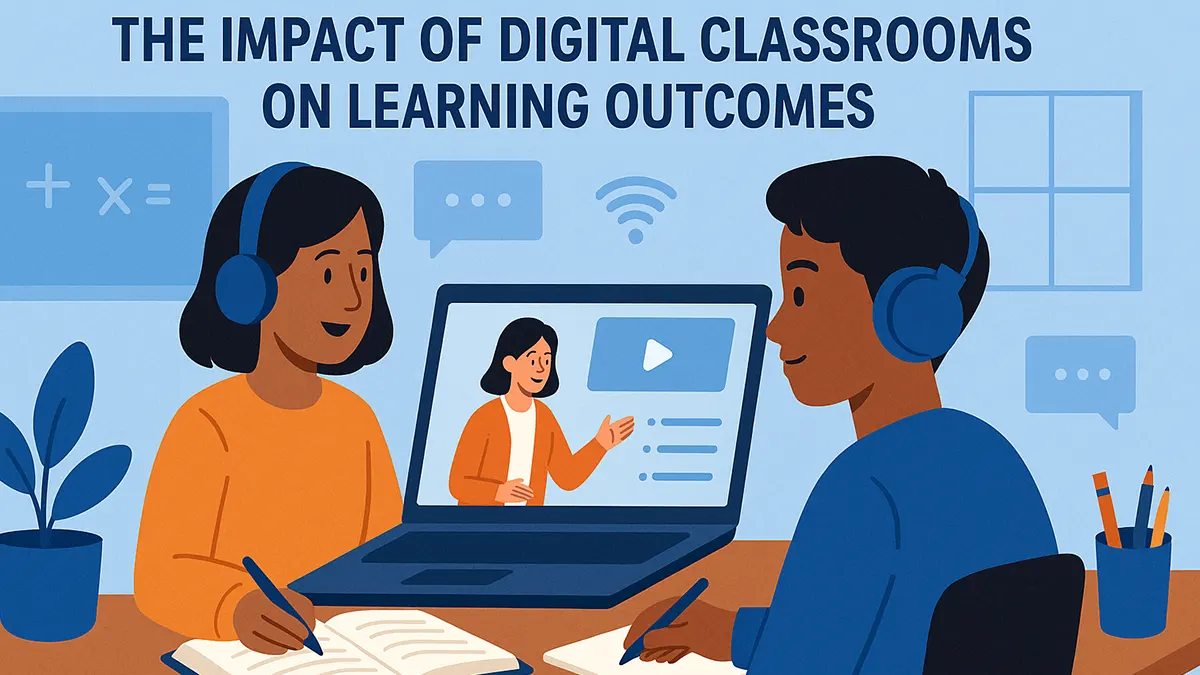The Impact of Digital Classrooms on Learning Outcomes

Strong 8k brings an ultra-HD IPTV experience to your living room and your pocket.
How digital classrooms are transforming educational settings? An analysis
Forbes says,’ the e learning industry reflected a record growth in 2020 world considering the pandemic situation, and it is predicted to reach new heights of $465 billion by the year 2028.’
While the stat is impressive, the forecast is not surprising. Given the rapid progress of the world toward technology, the education sector also needs to be aligned with new technologies. Technology in education, undoubtedly, is the need of the hour. Having said that, it is also important to consider that technology always has two sides. It is fruitful but, at the same time, may restrict or limit the student's potential. In the same light, we are going to discuss both sides of technology in 21st-century classroom settings. Let’s see what we find out:
Digital Classrooms: The Opportunities
Increased Access and Flexibility
With digital classrooms a common thing, students have greater access to classes and valuable materials. Whether they are at school or at home, they can easily take lectures. They can also read insightful content and increase their learning limitlessly. Such flexibility helps them balance their education and personal life. As a result, it leads to quality study outcomes.
Personalised Learning Experience
Digital classrooms offer students a study experience highly customised to their needs. These tools and learning systems assess students' expertise and serve according to their requirements. Examples include the Duolingo App and Khan Academy, which use adaptive learning, models to fit students' needs.
Engagement and Interaction
It is an important factor. Digital learning comes with engagement-focused elements. Students learn using gamified lessons, simulations, and highly interactive sessions. These also offer knowledge sharing and collaboration with peers. Interactive material and audio-visual elements make learning faster. Due to this, students perform better when they are in digital classrooms. It helps in enhancing understanding and concept clarity.
Access to Greater Knowledge
Digital classrooms offer a world of knowledge to students. They can easily access global expertise and latest research. This efficient and flexible access gives powerful progress to their learning. They learn well and deliver better in exams.
Learning For Students with Disabilities
A great advantage of digital classrooms is for students with disabilities. It helps such students to participate and engage in class speech to text software tools. This boosts their learning and improves their skills. Plus, it also delivers custom support for students according to their specialised needs and improvement areas.
Time management and performance Tracking
Digital classrooms use various types of learning management systems, including Google Classroom, Canvas, etc. These platforms help assign tasks and track students' progress easily. The regular assigning and tracking keep students on track with the coursework. As a result, they stay in touch with the course material. Plus, there are limited distractions in classes, and the study routine is managed effectively.
Flipped Learning
A very useful factor of digital classrooms is flipped learning. In this approach, teachers assign a video or reading lesson to students as homework. It is then discussed in class among students under the teacher’s guidance. This interactive discussion results in great learning advantages. This is because it offers diverse perspectives, shared learning, and a better understanding of the concepts.
Challenges in Digital Classrooms
Insufficient Digital Literacy
Digital classrooms require a significant mastery of digital skills to perform well. However, many participants, especially those from underserved areas, are not that much abled? This skill gap leads to difficulties in learning and accessing digital resources.
Quality and credibility Issues
Given the heavy reliance of students on online databases, quality assurance of learning has become difficult. Digital resources may not always be up-to-date or credible, which is damaging to student’s subject understanding and academic progress.
Loss of Guidance
In digital classrooms, maintaining students' motivation to study is hard. Without instructor or peer interactions like in traditional classrooms, students feel lost and lack guidance. This also develops feelings of isolation. Combined with screen fatigue and distractions, it may lead to more harm than learning flexibility.
Privacy Risks
Digital classroom technologies collect an increased amount of user data. This data collection may become a risk to students' privacy. Platforms can share it with other parties, or institutes may become vulnerable to cyber-attacks. These factors highlight the data security risks of digital learning. The misuse of students' academic info can also impact their educational outcomes.
Instructors’ Challenges
One of the main challenges of digital classrooms is teaching difficulties. Teaching in a traditional classroom is very different from teaching in an online setting. Therefore, teachers may find it hard to adjust their style to the digital space. They may not understand how to analyse students' critical skills, maintain their motivation, and assess their online performance in class.
Access to Resources
Digital learning depends on the presence of resources. Many students have no reach to internet facilitates, hardware tools and more. This makes it challenging for them to learn in digital classrooms.
While there are challenges to studying in digital classrooms, there are many successful examples of digitalising learning, too. One such example is online thesis help platforms. Employing professional thesis writers, such platforms help students with this difficult academic task. The help is completely online, with strict data security and customisation according to students' requirements. Students get personalised support from research assistance to drafting and more with field experts.
The Closing
Digital classrooms are the need of today’s highly advanced world. The new generation is living in a world where everything is technology led. So, why should their studies not align with current trends? This is productive not only for their academics but for their professional future as well. Technology teaches beyond just classroom skills. It prepares students to compete expertly in the current technological age. However, equal consideration should be given to the cons of digital classrooms.
Thoughtful planning and execution of standards are required to facilitate delivering digital classrooms in a motivated, engaged, learning-rich and secure environment. With this, we conclude our read, hoping the future will bring new opportunities and fewer risks for digital classrooms.
Note: IndiBlogHub features both user-submitted and editorial content. We do not verify third-party contributions. Read our Disclaimer and Privacy Policyfor details.


